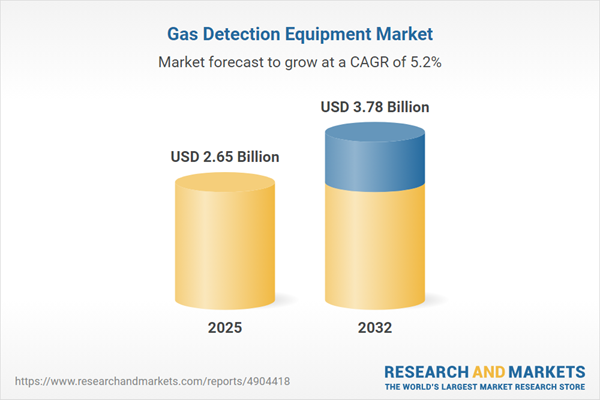Speak directly to the analyst to clarify any post sales queries you may have.
The gas detection equipment market is evolving quickly as organizations in high-risk sectors integrate advanced monitoring technologies to address escalating compliance demands and maintain operational resilience. Senior decision-makers are navigating a dynamic landscape where adaptive solutions and real-time capabilities are key to safeguarding assets and personnel.
Market Snapshot: Gas Detection Equipment Market
The Gas Detection Equipment Market is projected to expand from USD 2.52 billion in 2024 to USD 2.65 billion in 2025, achieving a CAGR of 5.20%. Looking ahead to 2032, the market is forecast to reach USD 3.78 billion.
This growth is underpinned by sustained investments in safety infrastructure, particularly across energy, healthcare, and manufacturing industries. Organizations are leveraging digital platforms to monitor hazards in real-time, which enables rapid incident response and strengthens compliance. Remote diagnostics and communications technologies help streamline regulatory reporting and support process optimization at scale. Together, these trends are shifting the market towards adaptive, data-driven operational models geared for risk mitigation and organizational efficiency.Scope & Segmentation: Strategic Insights for Senior Decision-Makers
This analysis delivers a comprehensive foundation for leaders evaluating capital allocation, technology selection, and procurement within the gas detection sector. Robust segmentation supports alignment of safety and compliance strategies to business objectives in global and emerging markets.
- Detector Types: Fixed systems offer extensive coverage for facilities, while portable and wearable detectors safeguard mobile teams and support distributed operations.
- Detection Technologies: Catalytic bead, electrochemical, infrared, photoionization, semiconductor, and ultrasonic sensors are matched to sector-specific risk profiles and compliance needs.
- End User Industries: Chemicals, healthcare, manufacturing, mining, oil and gas, power generation, and water treatment each require tailored gas detection strategies to address their operational risks.
- Gas Types: Solutions enable detection of combustible, toxic, and refrigerant gases, helping organizations minimize health risks and ensure swift intervention when necessary.
- Key Components: Integrated systems feature air pumps, calibration gases, controllers, analytics platforms, and multi-sensor modules, all contributing to high operational reliability.
- Sales Channels: Procurement flexibility includes direct sales, established distributor channels, and digital procurement, supporting a range of deployment models.
- Price Ranges: The portfolio spans diverse price points, catering to small-scale pilots as well as enterprise rollouts seeking scalable risk management.
- Geographies: Regional insights encompass adoption patterns and regulatory developments in the Americas, Europe, Middle East and Africa, and Asia-Pacific, reflecting varied maturity and standards.
- Featured Companies: Benchmarked leaders include Honeywell International Inc., MSA Safety Incorporated, Drägerwerk AG & Co. KGaA, Industrial Scientific Corporation, Emerson Electric Co., Riken Keiki Co., Ltd., Teledyne Technologies Incorporated, Siemens AG, ABB Ltd., and Crowcon Detection Instruments Ltd.
Key Takeaways: Strategic Guidance for Decision-Makers
- Cloud-based platforms provide organizations with heightened visibility, allowing for immediate responses to safety events and ongoing improvement of protocols.
- Gas detection hardware is engineered for intrinsic safety standards, supporting flexible compliance as regulatory expectations shift across regions and sectors.
- A growing focus on portable and wearable solutions addresses safety needs in distributed and remote work environments, empowering organizations to better protect field personnel.
- Close collaboration between solution providers, regulatory agencies, and workplace safety managers accelerates the adoption and harmonization of gas detection technologies.
- Increased investment in infrastructure—particularly in healthcare and utilities—is driving shifts in compliance management, helping organizations manage reputational risks during operations expansion.
Tariff Impact and Supply Chain Adaptation
- US tariffs on critical gas detection equipment components are driving market participants to diversify their supplier networks, enhancing supply chain resilience.
- Strategic moves such as near-shoring and focused sourcing from key regions support stability and help mitigate disruptions to material supply and cost fluctuations.
- Organizations are employing flexible procurement tactics, allowing rapid adaptation to regulatory changes and volatile costs, which helps ensure business continuity.
Methodology & Data Sources
This research draws on validated secondary data and comprehensive expert peer review across procurement, science, and engineering. All insights are grounded in respected industry databases, academic publications, and official regulatory sources, providing management with authoritative information for technology investment.
Why This Report Matters
- Enables senior executives to proactively address evolving operational and compliance needs in a rapidly transforming gas detection equipment market.
- Delivers practical segmentation and regional analysis, informing intelligent investment strategies and expansion planning across diverse high-priority industries.
- Presents evidence-based recommendations to enhance safety and minimize risk, empowering organizations to stay ahead of global compliance shifts.
Conclusion
With insights from this report, leaders can implement robust gas detection strategies that advance compliance and reinforce resilience within complex, regulated work environments.
Additional Product Information:
- Purchase of this report includes 1 year online access with quarterly updates.
- This report can be updated on request. Please contact our Customer Experience team using the Ask a Question widget on our website.
Table of Contents
3. Executive Summary
4. Market Overview
7. Cumulative Impact of Artificial Intelligence 2025
Companies Mentioned
The companies profiled in this Gas Detection Equipment market report include:- Honeywell International Inc.
- MSA Safety Incorporated
- Drägerwerk AG & Co. KGaA
- Industrial Scientific Corporation
- Emerson Electric Co.
- Riken Keiki Co., Ltd.
- Teledyne Technologies Incorporated
- Siemens AG
- ABB Ltd.
- Crowcon Detection Instruments Ltd.
Table Information
| Report Attribute | Details |
|---|---|
| No. of Pages | 192 |
| Published | October 2025 |
| Forecast Period | 2025 - 2032 |
| Estimated Market Value ( USD | $ 2.65 Billion |
| Forecasted Market Value ( USD | $ 3.78 Billion |
| Compound Annual Growth Rate | 5.2% |
| Regions Covered | Global |
| No. of Companies Mentioned | 11 |









